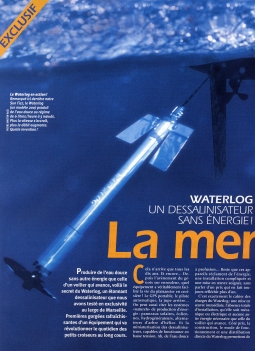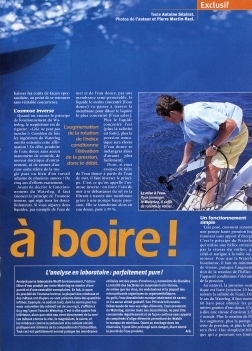|
 
(Banner heading over double page spread)
Click images to see larger versions
|
Waterlog
A watermaker that needs no electricity !
Pigs will fly !
The waterlog in action !
Shown behind our Sun Fizz, the Waterlog (a model 200), produces drinking water at the rate of 6 liters per hour at 5 knots. the higher the speed,
the higher the output.
What an invention !
To produce pure water without needing any energy source aboard a sailing boat is the secret of Waterlog. We have exclusively tested this
desalinator near Marseille. We got the first refreshing swallows from this equipment which will revolutionize the everyday life aboard, from small cruisers to
long haul yachts.
This only happens once every ten years. Even then..... When has there last been any truly new equipment to enhance the quality of life for the
cruising elite ? Comparisons may be the advent of the portable GPS, and the autopilot.....
We can think of natural systems for the production of energy, solar panels, wind generators and turbine generators. The development of smaller
watermakers capable of functioning with a little less power...... Ah, but to have as much drinking water as you could wish for...... now, that is something else. Most of them
require lots of energy, a complicated installation, and a price that makes many people think twice about having one on board.
This is exactly where Waterlog comes in: it can be used immediately, for there is a total absence of any installation because there are no
mechanical or electrical parts involved and no energy at all is needed other than the movement of the boat. As for price, functionality, high quality of make and distribution of
Waterlog is concerned, this brings the price down spectacularly, in fact, there is just nothing like it.
Reverse osmosis. When you announce what Waterlog does, a skeptical response is universal, "It just cannot possibly work !" We must wonder how many times
the engineers at Waterlog have heard this rebuttal ? To create drinking water without any control instruments, systems, electric motors, no valves of any
kind...... This sounds more like magic than reality - or the work of many years ! It is a fact that it originally took five years to bring this to fruition.
Before explaining how Waterlog works, one must explain the principle of reverse osmosis, a principle which governs all desalinators. If you separate two
liquids, say, sea water and pure drinking water, with a semi-permeable membrane, the least concentrated liquid (the drinking water) will pass through the membrane to dilute the
contaminated liquid which is the salt water. The more salty the liquid the higher the osmotic pressure becomes. If you want to make drinking water from sea water, you must reverse
the principle. Thus it is called `reverse osmosis`. When you force the saline water to break away the salt by filtering it with a membrane using a high pressure pump, then you will
get drinking water which is usually 99% pure.
The laboratory analysis: Perfectly pure !
The water analysis was done by Wolff Environmental Laboratories:- The water produced by the Waterlog was found to be of a
purity and neutrality that is exemplary. In fact, due to the procedure of reverse osmosis, the majority of minerals and metals had been removed and only remained in minute
quantities. For example, tap water contains about 200 mg/L, and the Waterlog product contained only 61.5 mg/L. This means that the
water is four times better than tap water, in spite of the fact that it came directly from the sea.
Metals such as zinc, magnesium, copper and minerals such as potassium and calcium were shown to be virtually eliminated. This
could be expected as the membrane pores used are only 0.5 nanometers in diameter. All of the bacteria in suspension, viruses, endotoxins and the majority of micropollutants and
metalorganic traces were removed.
As to the taste, the water is devoid of any taste or flavour and the PH is neutral. Without these elements, the water
produced by Waterlog cannot be consumed indefinitely without having another food source of vitamin supplements. As for storing the water, it can be stored for a very long time
without expecting purity degradation.
(End of lab. report panel)
(Side panel under picture of man putting it in the water):-
A simple operation
How can anyone conceive of a high pressure pump working without any power ? Clever, the principle of Waterlog exploits a propeller which
rotates proportional to the speed of the boat, irrespective of whether you are navigating under sail or engine. For Waterlog to work you need a minimum speed as the quicker the
rotation of the propeller, the more pressure is created. In nature, osmotic pressure is high, 29 bar. In the case of Waterlog, it makes 60 bar for the first droplets of drinking
water, which requires that the speed must be 3.5 to 4.0 knots. The more the speed increases, the more pressure the pump creates and the more water is produced. It is a simple
Biblical fact though that this must have an eventual limit.
|

